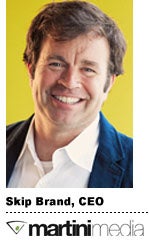 Martini Media, the online ad network focused on targeting young “affluent” audiences for the past four years, is broadening its offerings to the programmatic side. Martini’s move reflects a number of factors reshaping the online ad landscape, but the shift is not without pitfalls.
Martini Media, the online ad network focused on targeting young “affluent” audiences for the past four years, is broadening its offerings to the programmatic side. Martini’s move reflects a number of factors reshaping the online ad landscape, but the shift is not without pitfalls.
For one thing, the ad network model in general is under pressure and many companies associated with it are attempting to make the change. Some are doing it cosmetically, insisting that they be called “platforms,” not “networks.” Over the past year, others have tried a hybrid approach — most notably quadrantOne, which was shuttered late last month, and adBrite, which failed to find a buyer earlier this year and has been attempting to sell of parts of the company the past few weeks. This week, Cox Digital Solutions abandoned its in-house, Adify-built ad serving business and opted to go with Collective, which has evolved from its display network beginnings over the years.
To be clear, Martini Media, with its focus on upper income audiences and brand publishers, was never a “general” ad network. “For us, there’s been so much talk about real-time bidding, but not enough about real-time branding,” Martini Media CEO Skip Brand told AdExchanger about the goals for its new programmatic system. “Brand advertisers are making it known that they would like to be doing more programmatic media buying, so that’s why we’re doing this now.”
Martini Media’s new private marketplace is an extension of its Martini Live exchange it unveiled in Q3 2012, Brand said. With all the talk of “programmatic premium” San Francisco-based Martini Media is pitching the offering as a tool that will combine real-time bidding and automation with “guaranteed, 100%t ready-to-run, truly premium rich media and tablet inventory.”
Martini Media’s affluent target are hardly “1 percenters.” Brand defines the group as those making $100k annually and up. We asked Brand to define what the premium aspect of Martini Media’s programmatic marketplace is:
“To start, we define ‘premium’ as advertising aimed at a $100k-plus audience, followed by guaranteed inventory,” he said. “Secondly, premium is about brand advertising with IAB Rising Stars rich media units — which is similar to TV advertising, in that it’s one ad engaging with a consumer at one time.”
He continued, “It needs to have video within the unit, which tends to raise the… CPMs. In addition to that, premium ads must come attached with first-, second- and third party data. Lastly, it should be measured like TV, such as validated GRPs or Nielsen’s Online Campaign Ratings.”
The private marketplace’s debut is being timed ahead of the 2013 Television Network Upfronts and the New Digital Upfronts, which was started as counter-programming against the annual TV ad sales negotiating period and is a time when marketers and agencies are looking for places to spend their money for the fall primetime season.
Martini Media’s marketplace launch partners include display video specialist AdGent, which will concentrate on delivering tablet ads; AppNexus (“We eventually need to be on multiple exchanges, but AppNexus is a great one to start with” Brand said); Forbes (“This is what we mean when we talk about premium content,” he noted); nPario for data management; and MOAT for display measurement.
So where does all this effort behind the private marketplace leave Martini Live?
“The great thing about being a startup is that you get to cannibalize yourself,” Brand said. “Martini Live continues to grow and it has standard media and it will be dovetailed into the programmatic marketplace. The two will work side by side. But it’s all just following the marketplace. Last year, 20% of our business was programmatic, and this year it will be 30%. By next year, 50% of our business will be automated. We’ve been laying the groundwork for that to happen more quickly than it would otherwise. Plus, you can’t fight innovation. And more often than not, that tends to mean employing more automation in whatever it is you do.”












